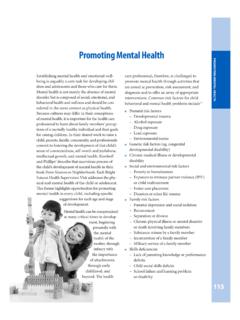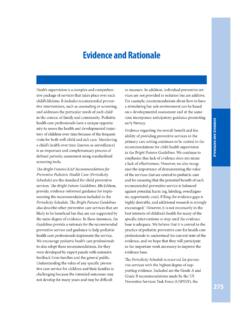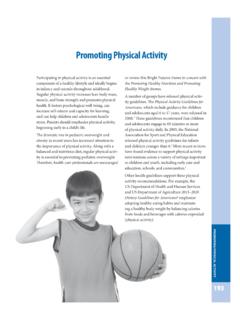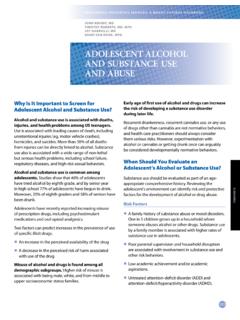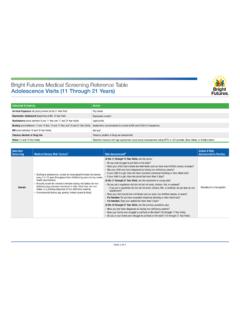Transcription of Nutrition Supervision - Bright Futures
1 Bright FUTURES17 Bright Futures : NUTRITIONN utrition SupervisionInfancyBright FUTURES19 Bright Futures : NUTRITIONI nfancyBright FUTURES21 Bright Futures : NUTRITIONI nfancyInfancyCONTEXTI nfancy is a period marked by the most rapid growth and physical development experi-enced throughout life. Infancy is divided into several stages, each of which is unique in terms of growth, developmental achievements, Nutrition needs, and feeding patterns. The most rapid changes occur in early infancy, between birth and age 6 months. In middle infancy, from ages 6 to 9 months, and in late infancy, from ages 9 to 12 months, growth slows but still remains the first year of life, good Nutrition is key to infants vitality and healthy develop-ment. But feeding infants is more than simply offering food when they are hungry, and it serves purposes beyond supporting their growth.
2 Feeding also provides opportunities for emotional bonding between parents and practices serve as the foundation for many aspects of family development (ie, all members of the family parents, grandparents, siblings, and the infant develop skills in responding appropriately to one another s cues). These skills include identifying, assessing, and responding to infant cues; promoting reciprocity (infant s responses to parents, grand-parents, and siblings and parents , grandparents , and siblings responses to the infant); and building the infant s feeding and pre-speech skills. When feeding their infant, parents gain a sense of responsibility, experience frustration when they cannot interpret the infant s cues, and develop the ability to negotiate and solve problems through their interactions with the infant.
3 They also expand their abilities to meet their infant s infants to grow at appropriate rates, they need adequate calories and essential nutri-ents. Conversely, poor growth is an important indicator of nutritional after birth, infants lose approximately 10% of their body weight because of fluid loss and some breakdown of tissue. They usually regain their birth weight within 7 days. Typically, infants double their birth weight by age 4 to 6 months and triple it by age 1. On average, infants gain 4 to 7 oz per week in the first 4 to 6 months and 3 to 5 oz per week from ages 6 to 18 months. Infants usually increase their length by 50% in the first year of life, but the rate of increase slows during the second half of the year. From birth to age 6 months, infants gain approximately 1 inch a month, and from ages 6 to 12 months, they gain about a half inch a rates of exclusively breastfed and formula-fed infants differ.
4 Breastfed infants grow more rapidly during the first 6 months of life but less rapidly during the remainder of the first 3 Infants growth depends on Nutrition , perinatal history, genetic factors (eg, parental height, genetic syndromes, disorders), and other physical meet growth demands, infants require a high intake of calories and adequate intakes of fat, protein, vitamins, and minerals. During the first year of life, breast milk, infant formula, or a combination of both provide 40% to 50% of calories from fat and are thus Bright FUTURES22 Bright Futures : NUTRITIONI nfancyimportant sources of calories, essential fatty acids, and fat-soluble vitamins. Fats should not be restricted during the first year of For full-term infants, breast milk from a well- nourished mother offers enough vitamins and minerals, with the exception of vitamin D, during the first 6 months.
5 Infants who are born at term usually have sufficient iron stores for 4 to 6 months. However, since breast milk contains very little iron, breastfed infants are at risk of iron defi-ciency by age 6 months and should receive an iron supplement beginning at age 4 Ideally, mothers should exclusively breastfeed for a minimum of 4 months, but preferably for 6 Formula, when correctly prepared and given in adequate volume, provides sufficient amounts of all nutrients, including vitamins and minerals. Complementary (solid) foods can be introduced between ages 4 and 6 months when the infant is developmentally ready. After age 6 months, solid foods aid in the development of appropriate feeding and eating skills for all infants and provide additional nutrients to meet the Dietary Reference Intakes for breastfed developmental changes that occur in the first year of life have a profound effect on the way infants feed.
6 Newborns are able to locate the mother s breast, latch onto the nipple, and suck to receive colostrum and then milk. At about age 4 to 6 months, infants are developmentally ready (ie, when the tongue thrust reflex [pushing food out of the mouth] is fading, their sucking reflex has changed to allow more coordinated swal-lowing, they can sit with support, and they have good head and neck control) to eat complemen-tary foods. Over the next few months, they learn to chew and swallow, manipulate finger foods, drink from a cup, and ultimately feed themselves. In late infancy, infants physical maturation, mastery of purposeful activity, and loss of new-born reflexes allow them to eat a wider variety foods, including foods with different textures, than they were able to consume during early and middle infants grow, their ability to consume a greater volume and variety of food increases.
7 Thus new-borns need small, frequent feedings, whereas older infants are able to consume more vol-ume at one time and require fewer feedings. Newborns digestive systems can effectively digest breast milk or specifically designed infant formula. By age 3 months, an infant s digestive system has matured enough to allow the absorp-tion of more complex most infants, the first primary tooth appears at around age 6 months. Teeth erupt every few months, usually in right and left pairs alternat-ing between the upper and lower jaws, and pro-ceeding from the front of the mouth to the back. These first teeth, however, do not change how infants process food, because infants usually gum their food even if they have front infancy, the amount and type of physical activity that an infant engages in changes dramat-ically.
8 At first, infants spend most of their time sleeping and eating. Activity begins with reflexes that promote the infant s survival. For example, the rooting reflex causes the infant to turn his mouth toward the breast or bottle and suckle. Over the next few months, these reflexes disap-pear, and infants slowly gain control over their movements. With increasing control comes more physical activity, including sitting up, rolling over, crawling, standing, and eventually is an individual process. Some infants sit earlier than others. Some walk as early as age 9 months, and others walk months after their first birthday. Although the order in which infants acquire motor skills is typically the same, the speed with which they acquire them is different. The ways infants are held and handled, the toys they play with, and their envi-ronments all influence their physical activ-ity and motor skills development.
9 Families that play with their infants, encouraging roll-ing, crawling, and then walking, are nurturing age-appropriate need a nurturing environment and posi-tive feeding patterns to promote healthy eat-ing habits, learn to eat a balanced diet of varied foods, and learn to eat in the first year of life, feeding the hungry infant helps him learn to trust that his needs will be met. For optimal development, newborns should be fed as soon as possible when they express hunger. Parents must be careful observers of the infant s behavior, so that they can respond. The suck-and-pause sequence in breastfeeding or infant-formula feeding and behaviors such Bright FUTURES23 Bright Futures : NUTRITIONI nfancyas making eye contact, opening the mouth, and turning to the parent are an infant s first com-munication with her parents.
10 As infants become more secure in their trust, they can wait longer for feeding. Infants should develop feeding skills at their own in early feeding evoke strong emo-tions in parents and can undermine parenting confidence and parents sense of competency. Thus feeding difficulties must be addressed in a timely manner. Over time, parents become more skilled at interpreting their infant s cues and increase their repertoire of successful responses to those cues. As they feed their infant, parents learn how their actions comfort and physical contact between the infant and a parent during feeding facilitates healthy social and emotional development. A sense of caring and trust evolves, which lays the groundwork for communication patterns throughout healthy feeding relationship involves a divi-sion of responsibility between the parent and the infant.

